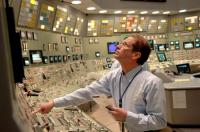CONTROL ROOM HARDWARE
 The above picture shows a Control Room Operator in a useful but old-fashioned control room that is still in service.
The above picture shows a Control Room Operator in a useful but old-fashioned control room that is still in service.
This operator is responsible for keeping the boiler on a college campus operating to provide hot water for sinks and showers and maybe even the hot water running through pipes of a room radiator.
Hot water is a utility, like electricity. Many public utility systems have older control rooms because it takes a lot of money to upgrade to modern digital control systems. Also, generating the "final products" of some public utilities...like hot water when the consumption history of the hot water is well known...doesn't typically require upgrading to the newest and fastest instrumentation for process control.
CONTROL ROOM HARDWARE
Control room hardware examples do not make interesting pictures. That being understood, PTOA Readers and Students can scrutinize the above picture to get a visual idea of what control room hardware looks like.
Controllers
Below the clock in the above picture is a rectangle and below that rectangle are three boxes with black lines crossing over them.
Each of the three boxes contains an indicating controller of some type; if the process temperature is being controlled, this device would be a TIC. Unlike the local Foxboro TIC shown in the previous PTOA segment, this TIC is mounted in a control board panel in the control room.

This is an example of an indicating controller that would be located in a control panel in the control room.
Eventually every controller fails. And when an individual controller has to be removed from the panel above it looks something like the photo to the right.
Annunciator Alarm Panels
To the left of the clock in the picture is an annunciator/alarm panel. The alarm panel is wired to light up and sound an alarm when there is a failure of some type out in the processing area. Maybe the level in a tank is too low or too high. Maybe a pump stopped working.
The Control Room Operator will immediately contact the outside Process Operator to investigate the problem and report back on the problem and solution.
 The picture to the left shows a Control Room Operator acknowledging an alarm from an annunciator/alarm panel. The alarm panel is above the Control Room Operator's head and wraps around the control room.
The picture to the left shows a Control Room Operator acknowledging an alarm from an annunciator/alarm panel. The alarm panel is above the Control Room Operator's head and wraps around the control room.
The alarm will not stop buzzing until it is silenced by a Control Room Operator. The light on the annunciator/alarm panel will not go off until the problem is fixed.
Recorders
Below the annunciator panel in the top photo are recorders that are recording the history of one or more process variables (Temperature, Pressure, Flowrate, and Level).
If the recorder is documenting the process variable Temperature, then this device is a Temperature Recorder (TR).
All recorders are gathering the history of the process. These devices have rolls of paper continuously moving (kind of like a cash register) while pens record operating parameters. The roll of paper changes color toward the end, alerting the Control Operator to put in a new roll.
Below is a close-up photo of a TR that could be found in the control panel of a control room.
Take Home Messages: Control room hardware...like controllers and recorders... look different from the local controllers and recorders but perform the same function. Annunciator/alarm panels alert Control Board Operators that something is wrong in the processing area. The Control Board Operator will have to acknowledge the alarm before it will stop buzzing. The Control Board Operator will instruct the outside Process Operator to investigate the problem.The annunciator panel light will not go off until the problem is fixed.
©2015 PTOA Segment 00010
Process Industry Automation
You need to login or register to bookmark/favorite this content.
